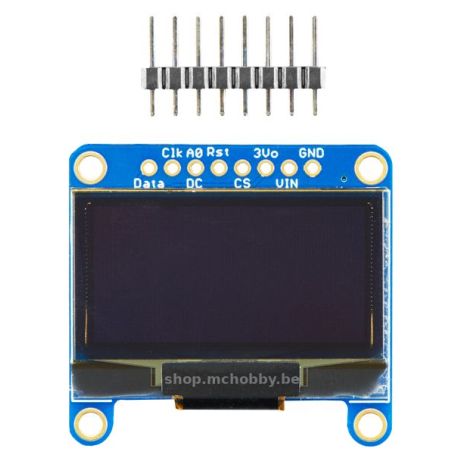128x64 Monochrome OLED display - 1.3" - I2C - StemmaQT / Qwiic
OLED Monochrome 1.3'' display
- 128x64 pixels
- Graphical display
- Interface: I2C
- Alim: 3.3V / 5V
- Logique: 3.3V / 5V
- StemmaQt / Qwiic ready
Payments are secured by LyraCollect, a French payment collection company.
It is possible to delivered to your home, to a pick-up point or picked up by appointment at MCHobby
We prepare, pack and ship your orders with great respect and care.
128x64 pixels OLED display - ready for fast prototyping
These displays are small, only 1.3'' (3.3cm) diagonal, but very easy to read thanks to the very high contrast of the OLED screens. This display is composed of 128x64 individual OLED pixels (A "pixel" represents a graphic point). Each of these pixels can be turned on/off by the controller.
Such a display does not require backlighting because it produces its own light. This reduces the energy consumption necessary for the function of an OLED and that is why it has such contrast.
It is for these crisp little details that OLED screens are so appreciated!
The control circuit is an SSD1306 capable of communicating in two different ways: I2C or SPI.
The OLED screen requires a 3.3V power supply and a 3.3V communication logic. AdaFruit has included a 3.3V voltage regulator and all pins have a level shifter, which means this display is safe to use with 5V devices!
The consumption of the screen depends directly on the number of lit pixels but on average, the display consumes 40mA with a 3.3V supply. The OLED driver circuit is a simple "capacitance-based energy storage pump" that transforms the 3.3-5V voltage into the high voltage needed to activate the OLED pixels.
AdaFruit offers an Arduino tutorial with library and example code to control the OLED display (see tutorial section, MCHobby will provide a translation as soon as possible). The tutorial covers the production of text and graphics. This OLED screen can also be used with a Raspberry Pi (see tutorial section)
You will need a microcontroller with more than 1K of RAM since this screen must be buffered (requires the use of a buffer memory). The library is able to display text, bitmap images, pixels (point), rectangles, circles and lines.
Technocal details
Board size:
- PCB: 35mm x 35mm
- Ecran: 35mm x 24mm
- Tickness: 5mm
- Weight: 8.5g
OLED Display:
- Display diagonal:1.30", so 3.3cm
- Resolution:128 × 64 (points)
- Color:Monochrome (white)
- COG
- Module zize (mm):34.50 x 35.00
- OLED Panel size (mm):34.50 x 23.00 x 1.45
- Active surface (mm):29.420 x 14.70
- Pixel Pitch, mm:0.23 x 0.23
- Pixel size (mm):0.21 x 0.21
- Weight (g):2.18
- Duty:1/64 (ignore la signification de cette information)
- Brightness ( cd/m2):100 (Typ) @ 12V
Tutorials
- Monochrom OLED for Arduino (AdaFruit, English)
- OLED Tron clock (AdaFruit, English)
- Using OLED display with Raspberry Pi (AdaFruit, English)
- Interface : Connector
- BREAKOUT, Qwiic StemmaQT
- Interface : Bus
- I2C
- Interface : Logic
- 3V
- Interface : Vcc (power)
- 3V3, 5V










